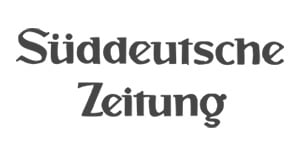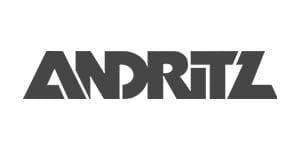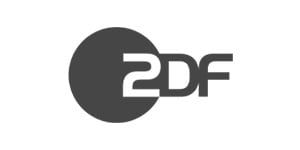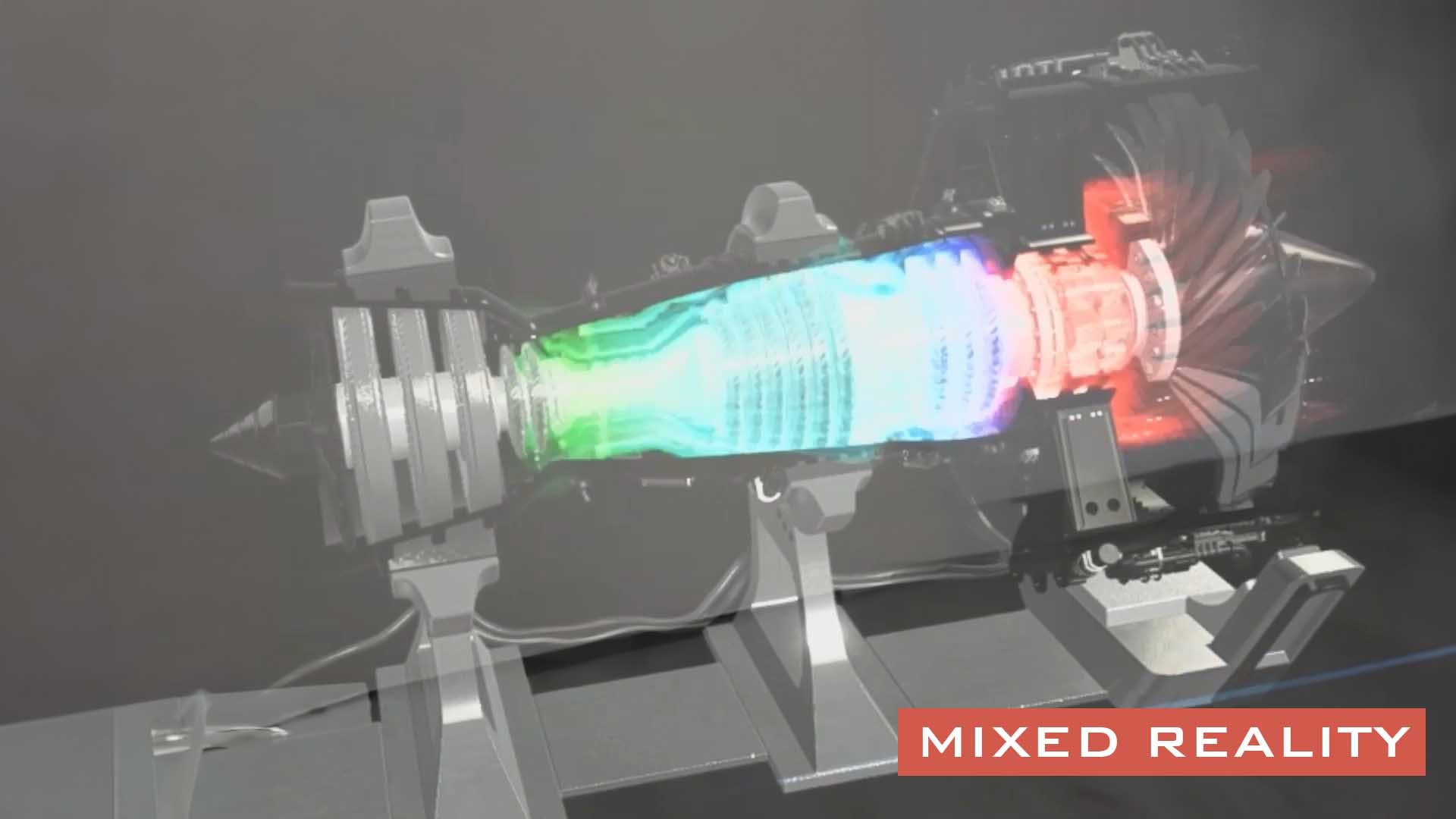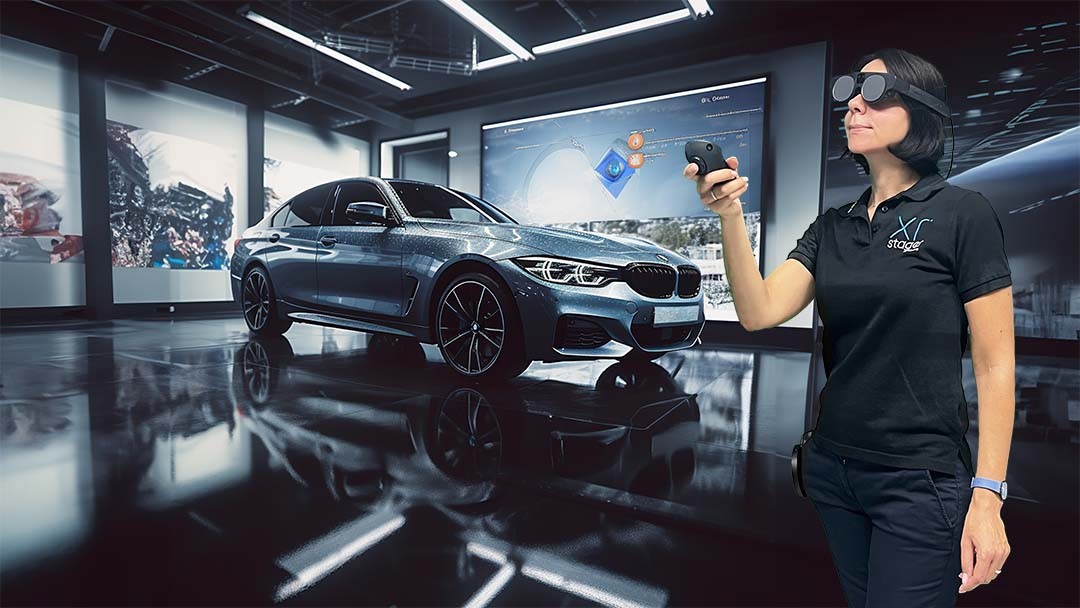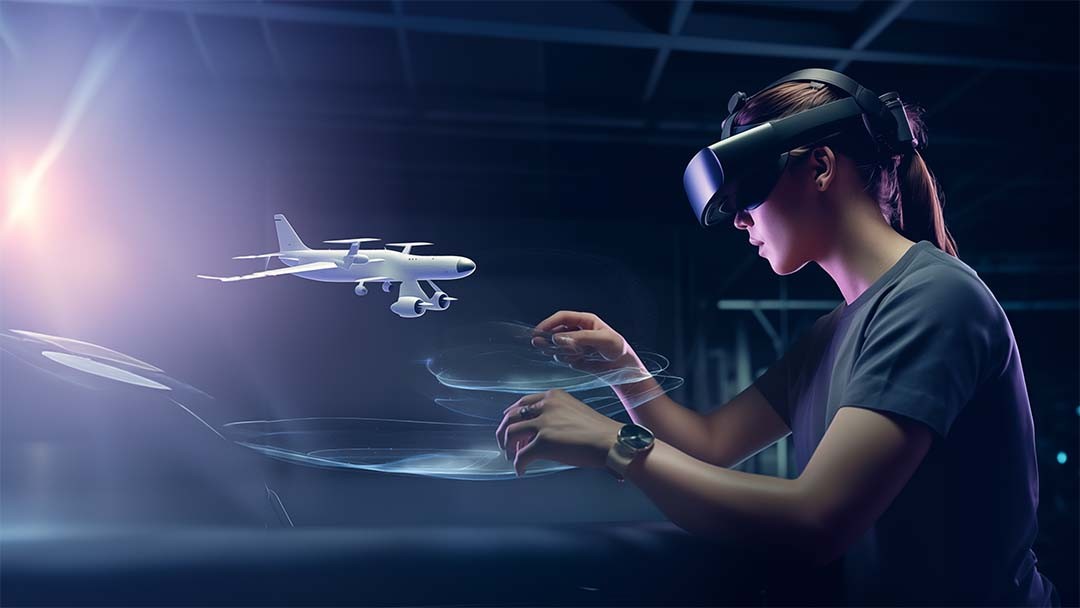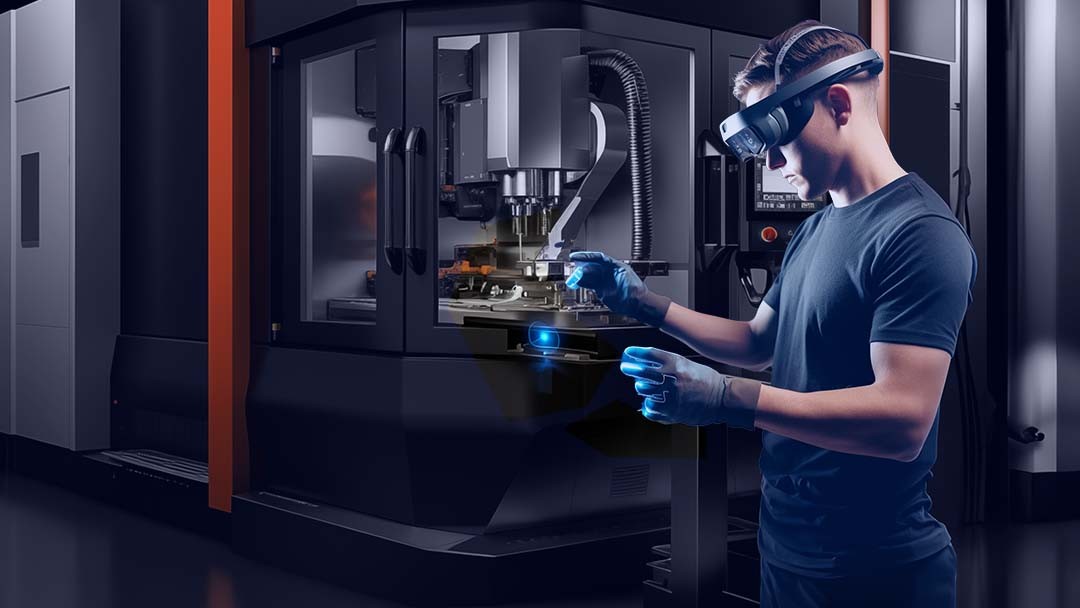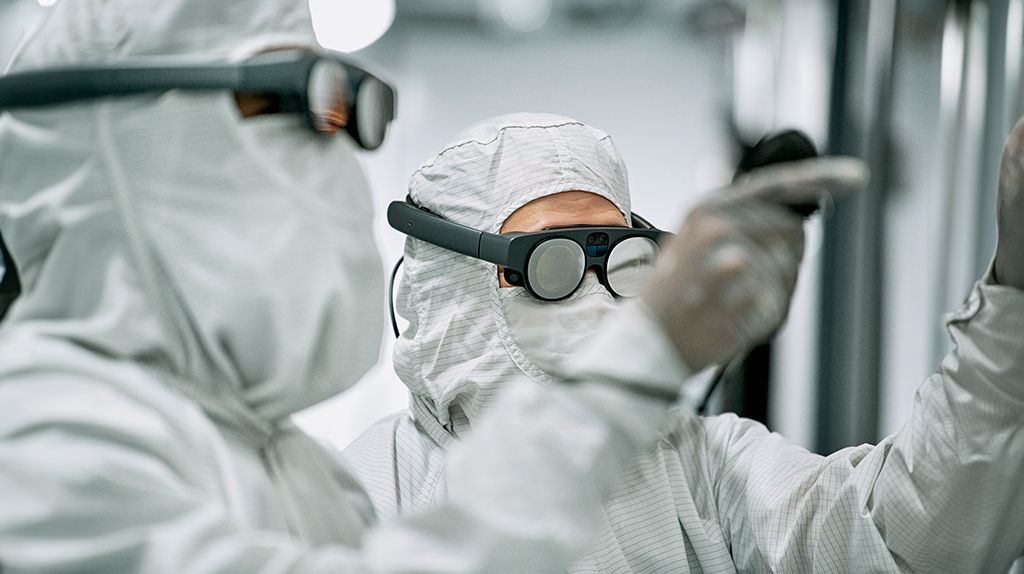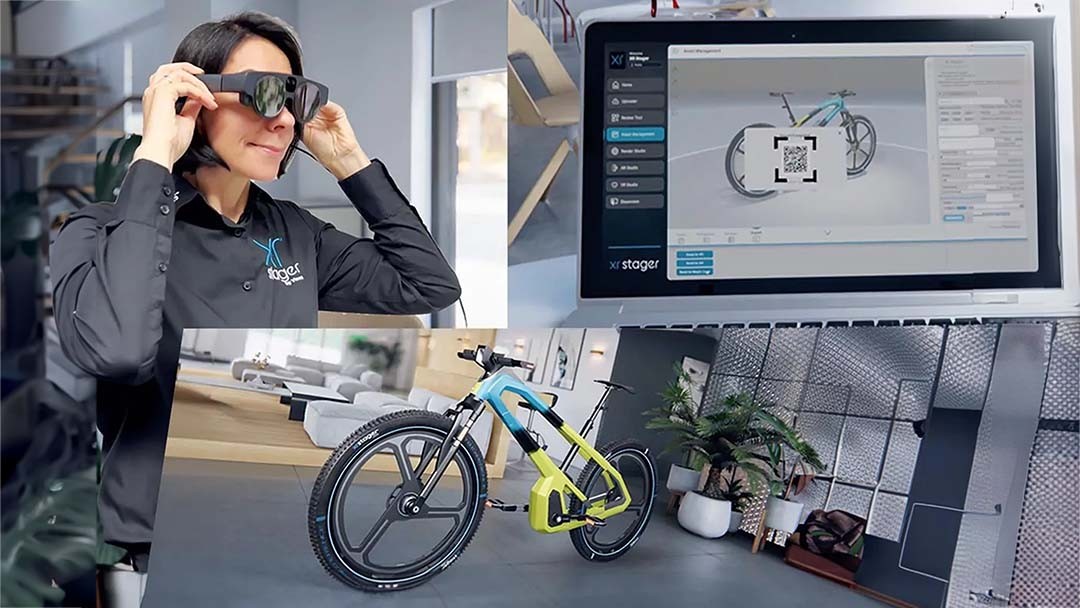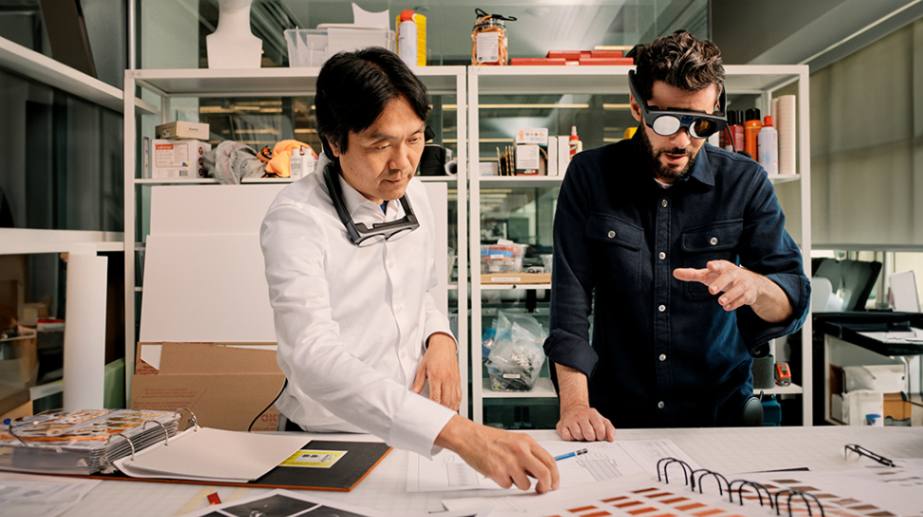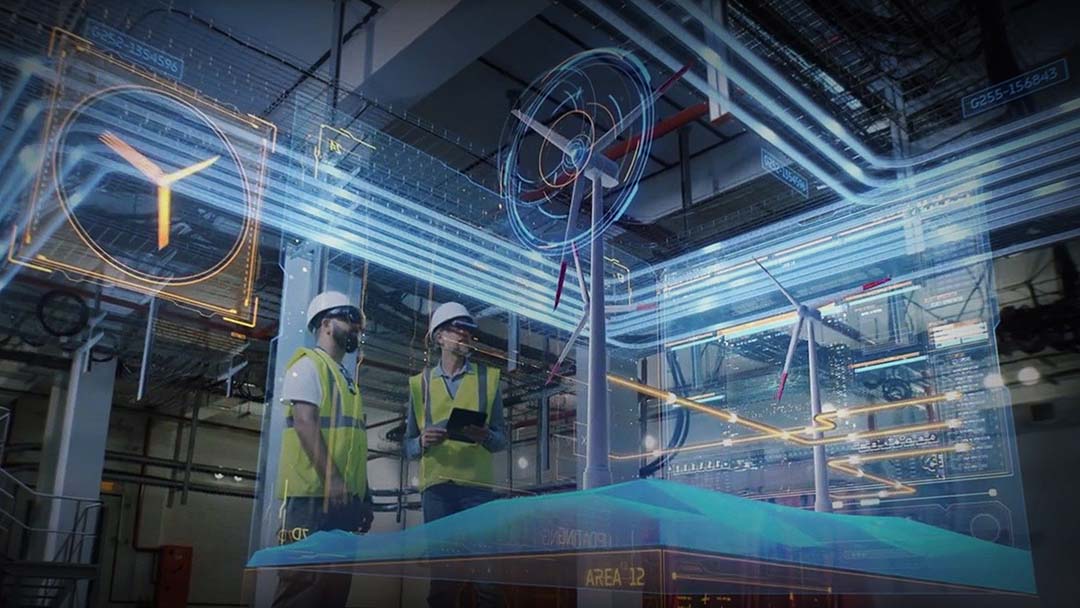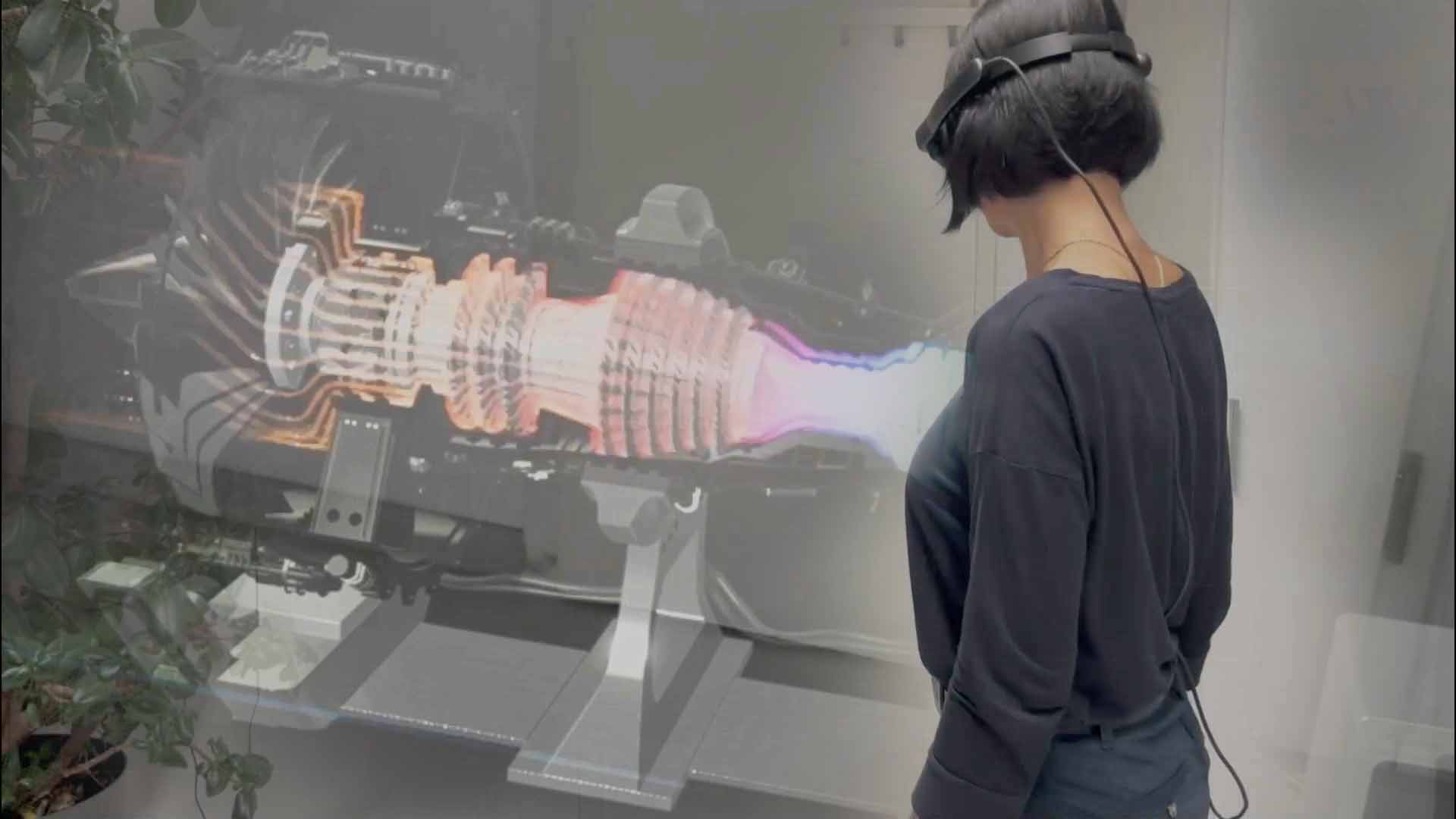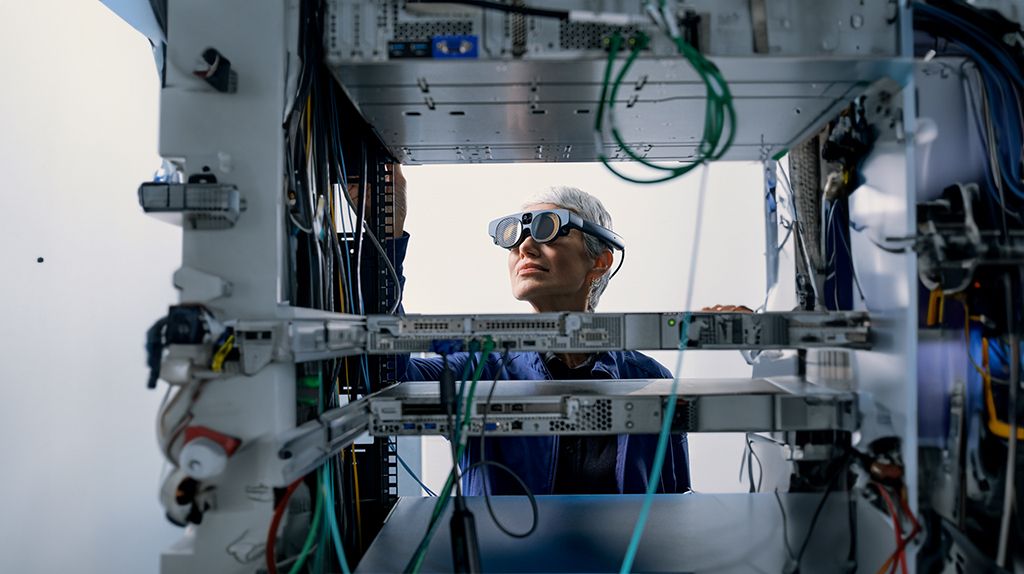Innovative mixed reality applications for development, service, and marketing
We’ll show you how mixed reality can revolutionize your development, service, and marketing strategies.
- Interactive Product Development: Use mixed reality to virtually create and test prototypes – efficiently and cost-effectively. Shorten development cycles by visualizing and interacting with 3D models in real-time.
- Enhanced Service Experiences: Provide next-generation customer service with interactive repair manuals and support through mixed reality – less downtime, more customer satisfaction.
- Marketing that Excites: Create unique customer experiences with immersive storytelling and product presentations that linger in memory. Transform static content into dynamic mixed reality experiences that differentiate your brand.
Our mission: to lead your company to the forefront of innovation with mixed reality solutions. Bring your products and messages to life and create an unforgettable connection with your target audience.
Mixed Reality Experiences (UX) for Business Success
What is Mixed Reality (UX)?
Mixed Reality (UX) is the seamless blending of real and virtual worlds to create new interactive experiences. By overlaying digital content onto the real environment, immersive experiences that merge both physical and digital elements are created.
By developing applications for leading hardware such as Magic Leap 2, Apple Vision Pro, and Meta Quest 3, we enable businesses to use Mixed Reality as an effective tool for training, sales, and operational processes. Our apps are tailored to maximize the unique capabilities of these devices and provide users with intuitive and productive interactions.
Our goal is to create applications that enhance your work processes and support your business objectives through a sophisticated Mixed Reality UX design strategy. Let’s push the boundaries of what’s possible together and drive the digital transformation of your company.
Why are Mixed Reality applications important for businesses?
Mixed Reality applications allow businesses to interact with their data and products in an unprecedented way. This type of visualization offers an immersive experience that far surpasses conventional presentations and helps to convey complex matters simply.
In industries where accuracy and attention to detail are crucial, MR applications provide the ability to realistically present and analyze products and processes in a controlled environment, saving time and costs and fostering innovation.
Incorporating MR into training can improve understanding and retention, while in marketing and sales, it brings products to life for customers, which can lead to increased customer engagement and revenue growth.
Why is the Visoric team the right partner?
The Visoric team in Munich brings extensive experience in the conception, design, programming, and support of Mixed Reality applications. We understand the specific challenges of businesses and develop customized solutions.
Our experts combine creative design with technical excellence to create applications that are not only technically innovative but also generate real added value for your business. We accompany you from the idea to implementation and beyond.
With Visoric, you choose a partner that places great importance on commitment to quality, customer proximity, and clear communication. We ensure that your investment in Mixed Reality applications means lasting success for your business.
Transform your business presentations with innovative Mixed Reality (UX) solutions from Visoric. Step into the future of customer experience. Let’s realize your vision together.
CAD Data as the Foundation for Efficient Mixed Reality (UX)
Unlock new ways to reduce development costs, enhance sales experiences, and optimize your service with Mixed Reality.
- Cost-Effective Development: Use interactive prototypes in Mixed Reality to speed up design iterations and cut development costs.
- Sales Enhancement: Boost your sales figures with compelling Mixed Reality product presentations that convince and excite customers.
- Service Innovation: Improve your customer service with Mixed Reality tools that simplify complex service processes and minimize downtime.
Leverage Mixed Reality (UX) to optimize your products, revolutionize sales experiences, and elevate your service to the next level. Start now!
How to reach us!
Email: info@visoric.com
Phone: +49 89 21552678
Contact Person:
Ulrich Buckenlei (Creative Director)
Mobile +49 152 53532871
Email: ulrich.buckenlei@visoric.com
Nataliya Daniltseva (Project Manager)
Mobile +49 176 72805705
Email: nataliya.daniltseva@visoric.com
Address:
VISORIC GmbH
Bayerstrasse 13
D-80335 Munich

Questions about Mixed Reality UX?
Would you like to learn more about how Mixed Reality can revolutionize your business processes and what specific benefits it can offer for your requirements? Our team is at your disposal. Contact us to discover more. We look forward to engaging with you!
Where are Mixed Reality Applications (UX) used in businesses?
Mixed Reality UX in the Automotive Industry
Areas of Application:
- Design and Prototyping: Virtual modeling and testing of vehicle designs in 3D, without creating physical prototypes.
- Training: Using Mixed Reality for training employees on handling new models and technologies.
- Showrooms: Presentation of vehicles in various configurations and colors through Mixed Reality applications.
Benefits:
- Cost and Time Savings: Reducing effort and costs in prototype development through virtual models.
- Enhanced Customer Experience: Customers can experience vehicles in various configurations, even if they are not physically present.
- Effective Training: Realistic training environments for employees, without the need for real vehicles or components.
Mixed Reality UX in Aerospace
Areas of Application:
- Maintenance: Overlaying maintenance information on real aircraft parts or systems for more precise repairs.
- Remote Assistance: Experts can provide support from a distance by projecting instructions directly into the technician’s field of vision.
- Safety Training: Conducting safety training in a virtual, risk-free environment.
Benefits:
- Increased Accuracy and Efficiency: Maintenance personnel receive precise instructions, leading to fewer errors and faster problem resolution.
- Improved Training Quality: Realistic simulations of complex scenarios facilitate understanding and retention of safety protocols.
- Reduced Downtime: Effective maintenance processes and immediate remote support minimize aircraft downtime.
Mixed Reality UX in Industrial Manufacturing
Areas of Application:
- Assembly Instructions: Display of interactive instructions directly in the workers’ field of view to support assembly processes.
- Quality Control: Enhancement of quality inspection processes by displaying relevant information and hints in the workspace.
- Layout Planning: Use of Mixed Reality for visualizing and optimizing machine and plant layouts before physical implementation.
Benefits:
- Increased Employee Efficiency: Faster onboarding and fewer errors through on-the-job assistance via Mixed Reality.
- Quality Improvement: Direct integration of control mechanisms into the work process leads to higher product quality.
- Optimized Space Utilization: Planning and testing of space concepts in a virtual environment enable better use of real production areas.
Mixed Reality UX in Healthcare
Areas of Application:
- Surgical Planning: Use of 3D models for detailed preparation and visualization of surgeries.
- Educational and Training Scenarios: Interactive learning environments for medical personnel to refine skills and procedures.
- Patient Consultation: Use of Mixed Reality to explain complex medical issues to patients in an understandable way.
Benefits:
- Improved Surgical Precision: Detailed visualizations assist surgeons in the precise execution of complex procedures.
- Enhanced Educational Opportunities: Realistic simulations allow medical staff to train skills in a safe environment.
- More Effective Patient Communication: The use of MR makes medical information more tangible and understandable for patients.
Mixed Reality UX in Retail
Areas of Application:
- Virtual Fittings: Customers can try on clothes and accessories in a virtual environment without having to physically put them on.
- Product Demonstrations: Detailed and interactive product visualizations that go beyond the traditional shopping experience.
- In-Store Navigation: Use of Mixed Reality for wayfinding and product localization within large sales areas.
Benefits:
- Enhanced Customer Experience: Interactive and personalized shopping experiences lead to stronger customer loyalty.
- Reduction of Returns: The option of virtual fitting decreases the likelihood of incorrect purchases.
- Improved Product Findability: Customers save time and experience less frustration searching for products thanks to Mixed Reality navigation.
Mixed Reality UX in Construction and Architecture
Areas of Application:
- Planning Visualization: Interactive 3D models assist in visualizing and assessing construction projects before the first stone is set.
- Error Checking: Mixed Reality can identify planning and execution errors early in the process to avoid costly corrections.
- Safety Training: Realistic simulation environments for safety training that minimize risks on construction sites.
Benefits:
- Increased Planning Efficiency: Better and faster coordination processes through joint viewing and real-time modification of models.
- Early Error Detection: Cost and time savings by discovering errors before they lead to problems in reality.
- More Effective Safety Training: Employees can be trained in a controlled environment for emergency situations, reducing the risk of accidents.
Mixed Reality UX in Agriculture and Food Production
Areas of Application:
- Plant Management: Monitoring growth conditions and plant health through Mixed Reality dashboards.
- Training for Machine Operation: Interactive guides and simulations for the efficient operation of agricultural equipment.
- Food Processing: Visualization of the process chains in food production for training and quality control purposes.
Benefits:
- Precision Agriculture: Increase in crop yields and resource efficiency through accurate data and real-time analyses.
- Optimization of Machine Utilization: Improved training leads to fewer operating errors and increased machine lifespan.
- Enhanced Food Safety: Mixed Reality tools assist in ensuring quality standards and traceability in food production.
Mixed Reality UX in Infrastructure and Energy Supply
Areas of Application:
- Maintenance Processes: Visualization of maintenance work on infrastructure facilities and energy plants.
- Planning Visualization: Representation and assessment of future infrastructure projects in a Mixed Reality environment.
- Emergency Response Training: Simulation of emergency scenarios for quick and effective responses in serious situations.
Benefits:
- Increased Safety: More accurate maintenance and faster identification of risks through overlaid information and instructions.
- Better Decision Making: Lifelike representations enable informed assessment of infrastructure projects.
- Efficient Crisis Management: Training in Mixed Reality prepares staff to handle emergencies, potentially reducing the impact of crises.
Mixed Reality UX in the Entertainment and Media Industry
Areas of Application:
- Interactive Content: Development of Mixed Reality games and experiences that immerse users in virtual worlds.
- Enhanced Live Events: Augmentation of concerts, sporting events, and other live occasions with interactive digital elements.
- Educational and Documentary Projects: Use of Mixed Reality to create immersive learning and documentary experiences.
Benefits:
- Enhanced Experience: MR enables a new level of interactivity and immersion for users, increasing engagement and loyalty.
- New Business Models: Unlocking new revenue streams through innovative offerings and experiences that are only possible with Mixed Reality.
- Educational Potential: Improved learning methods through interactive and realistic representations of complex subjects.
Mixed Reality UX in Education, Training, and Coaching
Areas of Application:
- Interactive Learning: Use of Mixed Reality to create interactive and engaging learning experiences for students and learners.
- Simulations: Utilization of Mixed Reality for realistic training scenarios in various fields such as medicine, flight schools, or the military.
- Remote Training: Conducting training sessions and courses in virtual classrooms, regardless of the participants’ location.
Benefits:
- Improved Retention: MR facilitates learning through visual and practical experiences, leading to better information retention.
- Safety in Training: Risk-free practice in simulated environments for dangerous or costly activities.
- Accessibility: Enables education and training for people in remote areas or with limited mobility.
Advantages of Collaborating with Visoric for Mixed Reality (UX) Corporate Applications
Benefits:
- Customized Mixed Reality Concepts: We create tailor-made Mixed Reality solutions that are specifically aligned with the needs and requirements of your company across various industries.
- State-of-the-Art Design & Technology: Our experts use advanced MR technology to design interactive and immersive applications with utmost precision and user-friendliness.
- Integration into Existing Systems: Our Mixed Reality applications are developed to seamlessly integrate into your current operational processes and IT infrastructures.
- Cross-Industry Expertise: Thanks to our broad range of experience, we bring a deep understanding of the specific challenges and opportunities across different sectors.
- Comprehensive Service from a Single Source: Visoric supports you from the concept to the final implementation of your Mixed Reality application, ensuring that your vision is effectively realized.
Explore selected examples of our Mixed Reality UX projects
Our fascination and enthusiasm have been dedicated for more than 14 years to the development of high-performance, exceptionally realistic, and didactically professional Mixed Reality (MR) User Experience solutions. We are excited to explore new levels of interactive and immersive user experience with you. Let’s create something extraordinary together.
Project in the Field of Mixed Reality UX
Revolutionary 3D XR Experiences with Magic Leap 2
Overview:
In close collaboration with Magic Leap, Visoric is revolutionizing the creation of mixed reality experiences by integrating the Magic Leap 2 into its XR Stager Authoring Platform.
Integration of Magic Leap Technology:
The integration of Magic Leap’s advanced mixed reality technology allows for taking immersive 3D design to a new level, perfectly suited for interactive presentations on the Magic Leap 2 headset.
Creation with the XR Stager System:
The XR Stager Authoring System leverages Magic Leap’s impressive capabilities to seamlessly render 3D experiences from CAD data in real-time – demonstrated by XR expert Natalia Daniltseva.
Key Features in Cooperation with Magic Leap:
- Import of texts, videos, and 3D data via the cloud with Magic Leap optimization.
- Code-free creation of 3D experiences, tailored for Magic Leap 2.
- Real-time moderation and customization of 3D content on the Magic Leap headset.
- Support for multi-user sessions on various devices, including Magic Leap 2.
- Efficient integration into data and product lifecycle management systems (PLM).
Project in the Field of Mixed Reality UX
Development of a Simulation Environment for BMW AG
Overview:
Visoric has created an advanced simulation platform for BMW AG, which allows for the design and testing of windshield displays and head-mounted units (HMUs) for vehicles within a mixed reality environment.
Innovation in the Design Process:
This custom platform enables automotive OEMs to create and configure symbology. By integrating real-time traffic data, designs can be transferred directly to mixed reality headsets and calibrated to appear to the user like real windshield displays.
Benefits for BMW AG:
The data gained from the simulation environment can be seamlessly fed back into BMW AG’s software environment, allowing for direct transfer and application in real vehicle development.
Efficiency and Cost Savings:
By using Visoric’s Duality simulation environment, development times can be significantly shortened and costs reduced, which accelerates the innovation cycle in the automotive sector and optimizes the launch of new technologies.
Project in the Field of Mixed Reality UX
Innovative Mixed Reality 3D Product Presentations with the XR Stager® Cloud Solution Platform
Overview:
Visoric is introducing the next level of product visualization with its AR Cloud Service and the Magic Leap 2 headset. Collaboration with leading industry partners enables the display of digital models as interactive mixed reality experiences in real space.
Technological Advancement:
Our platform makes complex 3D models accessible and interactive, allowing companies to visualize their products and processes without technical limitations. This promotes improved product development and customer interaction.
Customer Benefit:
With the Magic Leap 2 headset, users are able to see and experience products in their real environment. This supports companies in shortening decision-making processes and accelerating time-to-market.
Collaboration and Flexibility:
The XR Stager platform allows users to configure products, customize materials, and share configurations globally. This simplifies collaboration across different departments and locations and supports agile project management.
How to GO NEXT.
We are your experienced partner for Mixed Reality UX applications.
- Consultation: We identify your specific needs in the area of Mixed Reality UX and develop tailor-made concepts for an innovative user experience.
- Implementation: From the initial idea to the final Mixed Reality experience, we create applications that present your products or services in a new light.
- Support: Even after completion, we continue to support you by providing updates and assistance to ensure the relevance and attractiveness of your MR applications.
Find out how Mixed Reality UX applications can revolutionize the presentation of your company.
What you can expect from our Mixed Reality UX demo:
Real application examples: Discover how Mixed Reality UX applications can make your products and services come to life in fascinating and interactive scenarios.
Interactive experience: Immerse yourself in the world of Mixed Reality and explore how this innovative technology can transform your marketing and customer interaction.
Tailored consultation: Our experts are ready to analyze your individual needs and suggest personalized solutions in the area of Mixed Reality UX.
FAQ about Mixed Reality UX
What is Mixed Reality (MR) and how does it differ from VR and AR?
Mixed Reality (MR) is an advanced form of interactive experience that overlays the real world with digital content. It combines aspects of Virtual Reality (VR) and Augmented Reality (AR) to create an environment where physical and digital objects coexist and interact in real time. Unlike VR, which creates a completely virtual environment that the user immerses in, MR augments the real world with virtual elements and allows the user to see and manipulate both worlds simultaneously. AR, on the other hand, overlays digital information on the real world, but these interactions are typically less complex than in MR, where virtual and real objects can interact in ways that make them seem like a unified system.
MR enables users to move around and interact with both real and virtual objects, leading to new applications in education, design, manufacturing, and many other fields. For example, engineers wearing MR headsets could view virtual prototypes of machinery or parts within the real world and manipulate them before they are produced in manufacturing. This offers an immersive way to design, test, and modify in a cost-effective and time-saving manner.
How can Mixed Reality improve efficiency and productivity in my business?
Mixed Reality (MR) can enhance efficiency and productivity in your business in several ways:
- Training and Education: MR enables interactive learning and simulation-based training that is more realistic and memorable. Employees can learn complex tasks faster and reduce error rates.
- Maintenance and Repair: By overlaying digital information on physical objects, maintenance work can be done more accurately and swiftly, as MR instructions are displayed right in the technician's field of view.
- Design and Development: MR allows designers and engineers to visualize and manipulate prototypes in 3D without the need to create physical models, saving time and resources.
- Collaboration: Teams at different locations can work on the same 3D models in real-time, making adjustments, improving collaboration, and speeding up decision-making processes.
- Marketing and Sales: MR applications can offer potential customers an immersive understanding of products, leading to higher engagement rates and faster sales cycles.
- Customer Service: MR can enable customer service personnel to visualize issues and demonstrate solutions, enhancing service quality.
- Remote Assistance: Experts can provide guidance and support from a distance by projecting instructions directly into the field of view of a user on-site.
Overall, integrating Mixed Reality into your business can lead to increased efficiency by streamlining processes, reducing error rates, and improving customer engagement.
What are the costs involved in developing a Mixed Reality application?
The costs for developing a Mixed Reality application can vary widely, depending on factors such as project scope, content complexity, required hardware, and depth of integration with existing systems. Here are some considerations:
- Content Complexity: Intricate, interactive 3D models and environments cost more to produce.
- Development Timeline: A longer development timeframe can increase the overall costs.
- Customizations and Integrations: Custom-tailored solutions that need to integrate into existing company systems can drive up costs.
- Hardware and Software: The costs for necessary MR headsets or platform licenses must also be considered.
- Support and Maintenance: Ongoing technical support and regular updates may incur additional costs.
It's possible that simpler applications could be developed with a budget of a few thousand euros, while more complex, customized solutions can quickly reach into the six- or seven-figure range. An accurate quote typically requires a detailed requirements analysis.
How long does it take to develop a mixed reality application?
The development time for a mixed reality application greatly varies depending on the project's complexity and scope. Simple applications with standardized content may be developed within a few weeks, while more complex, customized solutions could take several months to a year or more.
Factors that influence development time include:
- Application Requirements: The more detailed and interactive the desired features, the longer the development time.
- Quality of Content: High-quality, realistic 3D models and environments require more time for creation and integration.
- Integration with Existing Systems: Linking the MR application with current corporate systems and databases can extend development.
- Technology Maturity: Newer or less mature mixed reality platforms may introduce development risks and require additional time for research and development.
- Testing and Iteration: Extensive testing scenarios and subsequent adjustments to the application based on user feedback also prolong the process.
For accurate timing, potential customers should work closely with developers early on to create a realistic schedule based on the specific project requirements.
Can existing data and systems be integrated into MR applications?
Yes, existing data and systems can be integrated into MR applications. Integrating current data sources and systems is a critical component of developing Mixed Reality applications to ensure a seamless and efficient user experience. This includes:
- Enterprise Databases: These can be connected to use real-time data within MR scenarios.
- CAD Models: Existing design data can be imported and transformed into interactive 3D models.
- ERP and CRM Systems: These can be incorporated to support business processes and introduce customer data into the MR environment.
- IoT Platforms: Sensor data from IoT devices can be used to feed MR applications with information from the real world.
MR solution developers often use APIs (Application Programming Interfaces) or specialized middleware to facilitate the connection between the MR application and existing company systems. This allows businesses to leverage their investments in existing IT infrastructure and create additional value by extending into the Mixed Reality space.
What software is needed for developing Mixed Reality applications?
Developing Mixed Reality applications requires specialized software that provides developers with tools to create virtual content and integrate it with the real world. Some of the key software packages and platforms in this area include:
- Unity: A widely used game and real-time 3D development platform that offers extensive support for Mixed Reality applications, including a range of tools and assets for development.
- Unreal Engine: A powerful engine for games and simulations known for its high-quality graphics, providing comprehensive features for AR and VR.
- Microsoft Mixed Reality Toolkit (MRTK): An open-source project by Microsoft that provides a collection of scripts and components to accelerate the development of Mixed Reality applications in Unity.
- Vuforia: An Augmented Reality software development platform that utilizes advanced computer vision technologies to recognize and track images and objects in the real world.
- ARKit (for iOS) and ARCore (for Android): Software development kits (SDKs) from Apple and Google that enable the creation of AR experiences on smartphones.
For specific content creation, 3D modeling and animation software such as Blender, Maya, or 3ds Max may also be required. Additionally, software for project management and collaboration, such as Git for version control or Slack for communication, may be important to support and coordinate the development process.
What hardware is required for implementing mixed reality?
Modern mixed reality applications require specialized hardware that is powerful enough to seamlessly blend complex virtual elements into the real world. Here are some of the most current devices being used in the field of mixed reality:
- Apple Vision Pro: This represents an advanced mixed reality headset promising high-quality immersion due to its design and technological capabilities.
- Magic Leap 2: An enhanced version of the mixed reality headset designed for professional use, distinguished by improved sensors and greater processing power.
- Meta Quest 3: The latest version of Meta's VR headset, which may also possess MR capabilities, would be ideal for immersive experiences and interactive applications across various industries.
In addition to these headsets, other hardware components and technologies are relevant to the implementation of mixed reality applications:
- AR-enabled Mobile Devices: Modern smartphones and tablets with advanced cameras and sensors can be used for MR experiences.
- Sensors and Cameras: Additional external devices for spatial and motion capture can increase the precision and interactivity of MR applications.
- Computing Platforms: Powerful computers or servers are often required to support the computationally intensive processes of MR software.
- Interaction Devices: Advanced controllers, gloves, or haptic devices can enhance user interaction with the virtual world and provide realistic feedback.
When selecting the right hardware for mixed reality, companies should also consider the longevity and developer community support. The needs and goals of the specific MR application ultimately determine the choice of hardware.
What security features do MR solutions offer for corporate data?
MR solutions for corporate data offer a variety of security features designed to protect and maintain the integrity of sensitive information. Key security features include:
- Data Encryption: Data stored on devices and transmitted data are encrypted to protect against unauthorized access.
- Authentication: Multi-factor authentication methods ensure that only authorized users can access MR applications and their contained data.
- Access Controls: Granular access permissions allow defining exactly who has access to what data and functions within the MR solution.
- Data Integrity Assurance: Mechanisms to ensure the immutability of data prevent unnoticed manipulation.
- Network Security: Secure network protocols and configurations prevent unauthorized data traffic and access.
- Regular Updates and Patches: Software updates and patches are provided regularly to close security gaps.
- Endpoint Security: Security mechanisms on MR headsets and other devices protect against malware and unauthorized access.
- Remote Wipe and Lock: In case of loss or theft of devices, data can be remotely wiped or devices locked to prevent data leaks.
- Security Audits and Compliance: Regular checks and adherence to industry-specific and legal data protection standards are ensured.
By combining these security features, businesses can take advantage of MR solutions while ensuring the security of their data.
How does MR impact the sustainability and ecological goals of my company?
Mixed Reality (MR) can have a positive impact on the sustainability and the achievement of ecological goals within your company:
- Travel Reduction: MR enables virtual meetings and product demonstrations, reducing the need for physical travel and associated CO2 emissions.
- Product Demonstrations: Virtual prototypes in MR can save physical prototypes, conserving materials and resources.
- Efficient Training: MR training programs require fewer physical materials and can offer energy savings by using virtual rather than physical venues.
- Operational Optimization: MR can contribute to increased efficiency in production processes by reducing error rates and minimizing the need for resources.
- Paperless Workflows: MR applications can help to reduce paper usage by providing digital documentation and instructions.
- Remote Work: MR can facilitate telework, thereby reducing energy consumption and emissions from commuting.
- Long-Term Use: MR systems can be used longer through updates and customizations, reducing the need for frequent hardware renewals.
However, it is important to consider the entire life cycle of MR technology, including the production of the hardware and its associated environmental impacts. By responsibly using the technology and implementing it effectively, a company can reduce its ecological footprint and contribute to sustainability.
Can MR applications help to visualize and understand complex data?
Yes, MR (Mixed Reality) applications can be extremely helpful in visualizing and making sense of complex data. By overlaying digital information onto the real world, MR allows for an intuitive representation of data and patterns that might otherwise be difficult to grasp. For instance, engineers and designers could view and interactively modify 3D models in their actual environment, which enables a better understanding of the data and its practical application. In medicine, surgeons might use MR to view precise anatomical structures in 3D, simplifying the complexity of medical imaging. In education, abstract concepts and data could be made tangible through interactive MR experiences, aiding learning processes. Overall, MR enhances data visualization and comprehension by providing an immersive and interactive experience that augments traditional methods of data analysis.
How is the ROI (Return on Investment) of an investment in Mixed Reality measured?
The measurement of Return on Investment (ROI) for investments in Mixed Reality (MR) depends on various factors and typically involves both quantitative and qualitative assessments. Here are steps companies generally take to measure the ROI of MR projects:
- Defining Specific Objectives: First, determine what the MR solution aims to achieve, such as improving employee training, increasing sales figures, enhancing customer experience, or boosting productivity.
- Identifying Total Costs: Total costs include the initial investment costs for hardware, software, development, and implementation of the MR solution, as well as ongoing costs for maintenance and support.
- Quantitative Analysis: Collect data before and after the implementation of the MR solution. This includes performance metrics such as time savings, error reduction, sales increase, or training cost reduction.
- Qualitative Analysis: Assess qualitative benefits, such as improved customer satisfaction, increased employee engagement, or enhanced brand perception.
- Comparing Past and Current Performance: Analyze the changes in relevant KPIs (Key Performance Indicators) to determine whether and to what extent the set goals have been achieved through the use of MR.
- Calculating Cost Savings and Revenues: Aggregate quantitative savings and revenue generation to gauge the financial overall impact of the MR solution.
- ROI Calculation: The ROI is then expressed as a percentage that reflects the ratio of net returns (or cost savings) to the total investment costs.
ROI=(Net Revenue (or Cost Savings)−Investment CostsInvestment Costs)×100
- Ongoing Monitoring and Adjustment: ROI should be monitored over time as the full benefits of MR investments often realize over the long term. Adjustments to strategy and MR applications may be needed to maximize ROI.
It's important to emphasize that the ROI from MR projects greatly depends on how the technology is utilized and integrated, and how well it meets a company's specific needs.
Can Mixed Reality applications be used remotely, for example, for teleworking?
Yes, Mixed Reality applications are highly conducive to remote work and can be utilized for telecommuting purposes. They enable users to virtually interact with colleagues and work environments as if they were physically present. With Mixed Reality, teams can collaborate on 3D models from different locations, conduct virtual meetings, and view and manipulate complex data within a three-dimensional space. This not only supports collaboration among teams that are distributed across various locations but can also enhance team bonding and engagement, as it provides a more immersive experience than traditional video conferencing.
How user-friendly are MR applications for non-technicians?
Mixed Reality (MR) applications are increasingly designed to be user-friendly for non-technical users. Intuitive user interfaces and interaction models, such as gesture and voice controls, facilitate access for those without technical expertise. Trainings and guided tutorials can further enhance usability, ensuring that MR technologies can be effectively utilized by everyone, regardless of their technical background.
What customization options are available for specific corporate needs?
Companies have various options for customizing Mixed Reality (MR) applications to their specific needs. These include:
- Custom User Interface Design: Companies can tailor the appearance and user experience of applications to align with their brand guidelines.
- Special Feature Development: Features can be developed based on the unique requirements of the business, such as specific data visualizations or interactive modules.
- Integration with Existing Systems: MR applications can be designed to integrate seamlessly with current operating systems and business software, like CRM or ERP systems.
- Scalability: Applications can be scaled for use across different departments and levels within a company.
- Data Security: Customizations can be made in the area of security to ensure the protection of confidential company data.
- Custom Content: Content can be tailored to specific products or services to create a unique customer experience.
- Training and Support: Providers of MR solutions often offer customized training and support to ensure that the applications are used to their full potential.
These customization options enable companies to streamline their processes, enhance employee interaction, and ultimately increase their competitiveness.
How does MR support collaboration and communication within a team?
Mixed Reality (MR) enhances team collaboration and communication through the following aspects:
- Shared Experiences: MR allows teams to see and work on the same 3D model or work environment in real time, regardless of the physical location of team members.
- Real-Time Interaction: Team members can communicate and interact within the MR environment in real time, offering the ability to give and receive immediate feedback.
- Visualization of Complex Ideas: Complex concepts and data can be visualized and intuitively understood by all team members, fostering a shared understanding.
- Effective Meetings: MR meetings can be more effective than traditional video conferencing, as participants can interact with virtual objects and discuss ideas in a three-dimensional space.
- Prototyping and Modeling: Teams can quickly and cost-effectively create prototypes and models in an MR environment, encouraging the creative process and iterative development.
- Training and Onboarding: MR can be used for training, with new team members being brought up to speed faster through interactive and immersive learning experiences.
- Task Management: Tasks and progress can be visually represented in MR and monitored by all team members, facilitating transparency and the collective achievement of goals.
By fostering a collaborative and interactive work environment, MR helps to overcome the barriers of physical distance and improve team productivity and efficiency.
How quickly can MR applications be developed and implemented?
The development and implementation timeline for MR applications can vary significantly depending on several factors:
- Complexity of the application: Simple MR applications might be developed within a few weeks, while more complex systems with specialized functionalities can take months or even years.
- Availability of resources: Having a sufficient number of developers and other resources can accelerate development.
- Integration into existing systems: The need to integrate the MR solution into existing company systems can require additional time.
- Custom content creation: Generating custom content and specialized tools can add to the development timeline.
- Testing and quality assurance: Thorough testing is necessary to ensure the application functions smoothly. Depending on complexity, this process can be time-consuming.
- Feedback loops: Iterations based on user feedback can extend development time but are crucial for user acceptance.
- Scaling and deployment: Scaling the solution for company-wide use and deploying across different devices and platforms requires additional time.
- User training: The implementation timeframe might also be extended by the need to train users on the application.
Typically, businesses can expect a prototype or initial version in a matter of months, while a full implementation may vary based on the factors mentioned above.
Which industries benefit the most from Mixed Reality applications?
The industries that benefit the most from Mixed Reality (MR) applications tend to be those that are highly visual and interactive or involve the processing of complex spatial information. These include:
- Manufacturing: For visualizing production processes, maintenance, and training on complex machinery.
- Architecture and Construction: For reviewing building plans in 3D and virtual walkthroughs of planned structures.
- Healthcare: For surgical planning and education by presenting anatomical models in 3D.
- Automotive Industry: For design, prototyping, and interactive customer experiences with new car models.
- Retail and Fashion: To offer customers virtual try-ons and showrooms.
- Education and Training: For immersive learning experiences, simulations, and virtual labs.
- Entertainment and Gaming: To create immersive entertainment experiences.
- Real Estate: For virtual house tours and interior design.
- Defense and Military: For training simulations and equipment testing.
- Tourism and Travel: For virtual trips and experiences in remote locations.
These industries benefit significantly as Mixed Reality offers the ability to present concepts and products in innovative ways, enhance training, and make complex data interactively usable.
What long-term maintenance and support options are available?
For Mixed Reality (MR) applications, a variety of long-term maintenance and support options are available to ensure continuous functionality and up-to-dateness:
- Standard Maintenance Contracts: These include regular updates, bug fixes, and technical support.
- Extended Support: Additional services can cover special requirements, such as prioritizing support requests or providing 24/7 assistance.
- Updates and Upgrades: Frequent software updates ensure that MR applications remain compatible with new versions of operating systems and hardware.
- Training Programs: Long-term training initiatives can help users keep pace with technological developments and use the MR application effectively.
- Customized Service-Level Agreements (SLAs): These contracts are tailored to the specific needs of the business and often include guarantees for response times in case of issues.
- Remote Monitoring and Diagnostics: Some providers offer remote monitoring services to proactively identify and resolve issues, often before users are even aware of them.
- Backup and Disaster Recovery: For critical applications, providers offer strategies for data backup and recovery in the event of failure.
- Community Support and Forums: Access to user communities and forums can help address common challenges and learn from the experiences of others.
Choosing the right maintenance and support options depends on the specific needs of the business and should be part of the overall strategy for implementing MR solutions.
How scalable are mixed reality applications for large enterprises?
Mixed reality applications are inherently scalable for large enterprises, as they can be modularly constructed and implemented at various levels of the organization. They can be tailored to suit different company sizes and requirements. Here are some key aspects to consider when scaling MR applications in large enterprises:
- Adaptability: MR applications can be designed for specific enterprise needs, from individual workflows to company-wide processes.
- Infrastructure: Large enterprises need to have a robust IT infrastructure to efficiently support MR applications, including adequate bandwidth and processing power.
- Device Management: As the number of MR devices grows, companies must establish effective solutions for device management and maintenance.
- Data Integration: MR applications must be able to interact with existing databases and systems to ensure seamless workflows.
- Security: With the increasing use of MR, data privacy and security must be ensured, especially when sensitive information is processed.
- User Training: Effective scaling requires that employees are trained and can competently use MR technologies.
- Continuous Support and Development: To keep pace with technological advancement, MR applications need to be regularly updated and improved.
By considering these aspects, large enterprises can successfully and efficiently scale mixed reality applications to enhance operational efficiency and maintain competitiveness.
What are the future development perspectives for Mixed Reality?
The future development perspectives for Mixed Reality (MR) are promising and point in several directions:
- Enhanced Everyday Integration: MR could become ubiquitous through continued miniaturization and enhanced user-friendliness. Glasses might become as commonplace as smartphones are today.
- Improved Hardware: Lighter, more powerful, and more energy-efficient MR glasses could be developed, with better resolution, larger field of view, and longer battery life.
- Extended Social Interactions: MR will change the way people interact by enabling virtual presences and interactions in real-time that overcome physical distances.
- Advanced Applications in Education and Training: MR can be used for realistic simulations, which is particularly useful in education and for training skills in safe environments.
- More Complex Data Visualization: MR will increasingly offer sophisticated tools for visualizing complex data, which will be particularly beneficial in fields like science, engineering, and medicine.
- Integration with Artificial Intelligence: Combining MR with AI could bring about intelligent assistants capable of reacting in real time to the environment and the user’s actions.
- Industrial and Commercial Applications: From maintenance and repair to design and marketing, MR applications could become standard across a variety of industries.
- Improvements in Healthcare: MR could assist surgeons with complicated procedures and support therapies by enabling patients to perform exercises in a controlled virtual environment.
- Impact on the Work Environment: With the ability to create virtual workspaces, MR could change the dynamics of the workplace, especially regarding remote work and global collaboration.
- Ethical and Social Implications: As MR becomes more integrated into personal and professional life, there will be important discussions about privacy, security, and social impact.
The future of Mixed Reality is closely tied to advancements in computing technology and shifts in our social and cultural behaviors.






